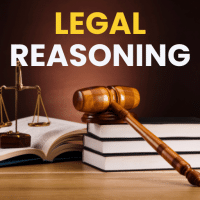CLAT Exam > CLAT Questions > If x, y and z are real numbers such that x + ...
Start Learning for Free
If x, y and z are real numbers such that x + y + z = 5 and xy + yz + zx = 3, what is the largest value that x can have?
- a)5/3
- b)13/3
- c)√19
- d)None of these
Correct answer is option 'B'. Can you explain this answer?
Verified Answer
If x, y and z are real numbers such that x + y + z = 5 and xy + yz + z...
The given equations are x + y + z = 5 — (1) , xy + yz + zx = 3 — (2)
xy + yz + zx = 3
x(y + z) + yz = 3
⇒ x ( 5 - x ) +y ( 5 – x – y) = 3
⇒ -y2 - y(5 - x) - x2 + 5x = 3
⇒ y2 + y(x - 5) + (x2 - 5x + 3) = 0
The above equation should have real roots for y, => Determinant >= 0
⇒ y2 + y(x - 5) + (x2 - 5x + 3) = 0
The above equation should have real roots for y, => Determinant >= 0
⇒ b2 - 4ac0
⇒ (x - 5)2 - 4(x2 - 5x + 3) ≥ 0
⇒ 3x2 - 10x - 13 ≤ 0
⇒ -1 ≤ x ≤ 13/3
Hence maximum value x can take is 13/3, and the corresponding values for y,z are 1/3, 1/3
Most Upvoted Answer
If x, y and z are real numbers such that x + y + z = 5 and xy + yz + z...
Step :-1)
From x + y + z = 5, we get y + z = 5-x.
From xy + yz + zx = 3, we get yz + x(y + z) = 3.
Substitute y + z: yz + x(5 – x) = 3.
So, yz = 3 - 5x + x^2
Step:-2)
Product of the roots = yz = 3-5x+x^2
Sum of the roots = y+z = 5-x
y and z are roots of the quadratic equation t^2 - (y + z)t + yz = 0.
Substitute the expressions from Step 1: t^2 - (5-x)t + (x2 – 5x + 3) = 0.
Step:-3)
Since y and z are real numbers, the discriminant of the quadratic equation must be non-negative.
D= b^2 - 4ac≥0
D = (-(5 – x))^2 - 4(1)(x^2 – 5x + 3) ≥ -0.
-3x^2+10x+13 ≥ 0.
Multiply by -1 and reverse the inequality: 3x^2 - 10x -13 ≤ 0
Step :-4)
Roots of the equation
3x^2 -10x -13≤0
x=-1 & x= 13/3
-1≤x≤13/3
From x + y + z = 5, we get y + z = 5-x.
From xy + yz + zx = 3, we get yz + x(y + z) = 3.
Substitute y + z: yz + x(5 – x) = 3.
So, yz = 3 - 5x + x^2
Step:-2)
Product of the roots = yz = 3-5x+x^2
Sum of the roots = y+z = 5-x
y and z are roots of the quadratic equation t^2 - (y + z)t + yz = 0.
Substitute the expressions from Step 1: t^2 - (5-x)t + (x2 – 5x + 3) = 0.
Step:-3)
Since y and z are real numbers, the discriminant of the quadratic equation must be non-negative.
D= b^2 - 4ac≥0
D = (-(5 – x))^2 - 4(1)(x^2 – 5x + 3) ≥ -0.
-3x^2+10x+13 ≥ 0.
Multiply by -1 and reverse the inequality: 3x^2 - 10x -13 ≤ 0
Step :-4)
Roots of the equation
3x^2 -10x -13≤0
x=-1 & x= 13/3
-1≤x≤13/3
Free Test
FREE
| Start Free Test |
Community Answer
If x, y and z are real numbers such that x + y + z = 5 and xy + yz + z...
Let's call the three numbers x, y, and z. We are given that x+y+z=5 and xy+yz+zx=3.
We can rewrite the first equation as x+y+z=5 as xy+yz+zx+2xy+2yz+2zx=3+2xy+2yz+2zx.
Adding the two equations together, we have 3+2xy+2yz+2zx=3+3+2xy+2yz+2zx.
Simplifying, we have 6=6+2xy+2yz+2zx.
Subtracting 6 from both sides, we have 0=2xy+2yz+2zx.
Dividing both sides by 2, we have 0=xy+yz+zx.
We can rewrite this equation as x(y+z)+yz=0.
Since x, y, and z are real numbers, we know that y+z and yz must have opposite signs (if they had the same sign, then their sum would not be zero).
This means that either y and z are both negative, or one of them is negative and the other is positive.
If both y and z are negative, then y+z is negative. Since the sum of three real numbers is 5, this would mean that x is positive.
However, if one of y or z is negative and the other is positive, then their sum y+z is positive. Since the sum of three real numbers is 5, this would mean that x is negative.
Therefore, x cannot be positive.
The largest value that x can have is 0.
Therefore, the answer is c) 0.
We can rewrite the first equation as x+y+z=5 as xy+yz+zx+2xy+2yz+2zx=3+2xy+2yz+2zx.
Adding the two equations together, we have 3+2xy+2yz+2zx=3+3+2xy+2yz+2zx.
Simplifying, we have 6=6+2xy+2yz+2zx.
Subtracting 6 from both sides, we have 0=2xy+2yz+2zx.
Dividing both sides by 2, we have 0=xy+yz+zx.
We can rewrite this equation as x(y+z)+yz=0.
Since x, y, and z are real numbers, we know that y+z and yz must have opposite signs (if they had the same sign, then their sum would not be zero).
This means that either y and z are both negative, or one of them is negative and the other is positive.
If both y and z are negative, then y+z is negative. Since the sum of three real numbers is 5, this would mean that x is positive.
However, if one of y or z is negative and the other is positive, then their sum y+z is positive. Since the sum of three real numbers is 5, this would mean that x is negative.
Therefore, x cannot be positive.
The largest value that x can have is 0.
Therefore, the answer is c) 0.

|
Explore Courses for CLAT exam
|

|
Question Description
If x, y and z are real numbers such that x + y + z = 5 and xy + yz + zx = 3, what is the largest value that x can have?a)5/3b)13/3c)√19d)None of theseCorrect answer is option 'B'. Can you explain this answer? for CLAT 2025 is part of CLAT preparation. The Question and answers have been prepared according to the CLAT exam syllabus. Information about If x, y and z are real numbers such that x + y + z = 5 and xy + yz + zx = 3, what is the largest value that x can have?a)5/3b)13/3c)√19d)None of theseCorrect answer is option 'B'. Can you explain this answer? covers all topics & solutions for CLAT 2025 Exam. Find important definitions, questions, meanings, examples, exercises and tests below for If x, y and z are real numbers such that x + y + z = 5 and xy + yz + zx = 3, what is the largest value that x can have?a)5/3b)13/3c)√19d)None of theseCorrect answer is option 'B'. Can you explain this answer?.
If x, y and z are real numbers such that x + y + z = 5 and xy + yz + zx = 3, what is the largest value that x can have?a)5/3b)13/3c)√19d)None of theseCorrect answer is option 'B'. Can you explain this answer? for CLAT 2025 is part of CLAT preparation. The Question and answers have been prepared according to the CLAT exam syllabus. Information about If x, y and z are real numbers such that x + y + z = 5 and xy + yz + zx = 3, what is the largest value that x can have?a)5/3b)13/3c)√19d)None of theseCorrect answer is option 'B'. Can you explain this answer? covers all topics & solutions for CLAT 2025 Exam. Find important definitions, questions, meanings, examples, exercises and tests below for If x, y and z are real numbers such that x + y + z = 5 and xy + yz + zx = 3, what is the largest value that x can have?a)5/3b)13/3c)√19d)None of theseCorrect answer is option 'B'. Can you explain this answer?.
Solutions for If x, y and z are real numbers such that x + y + z = 5 and xy + yz + zx = 3, what is the largest value that x can have?a)5/3b)13/3c)√19d)None of theseCorrect answer is option 'B'. Can you explain this answer? in English & in Hindi are available as part of our courses for CLAT.
Download more important topics, notes, lectures and mock test series for CLAT Exam by signing up for free.
Here you can find the meaning of If x, y and z are real numbers such that x + y + z = 5 and xy + yz + zx = 3, what is the largest value that x can have?a)5/3b)13/3c)√19d)None of theseCorrect answer is option 'B'. Can you explain this answer? defined & explained in the simplest way possible. Besides giving the explanation of
If x, y and z are real numbers such that x + y + z = 5 and xy + yz + zx = 3, what is the largest value that x can have?a)5/3b)13/3c)√19d)None of theseCorrect answer is option 'B'. Can you explain this answer?, a detailed solution for If x, y and z are real numbers such that x + y + z = 5 and xy + yz + zx = 3, what is the largest value that x can have?a)5/3b)13/3c)√19d)None of theseCorrect answer is option 'B'. Can you explain this answer? has been provided alongside types of If x, y and z are real numbers such that x + y + z = 5 and xy + yz + zx = 3, what is the largest value that x can have?a)5/3b)13/3c)√19d)None of theseCorrect answer is option 'B'. Can you explain this answer? theory, EduRev gives you an
ample number of questions to practice If x, y and z are real numbers such that x + y + z = 5 and xy + yz + zx = 3, what is the largest value that x can have?a)5/3b)13/3c)√19d)None of theseCorrect answer is option 'B'. Can you explain this answer? tests, examples and also practice CLAT tests.

|
Explore Courses for CLAT exam
|

|
Signup for Free!
Signup to see your scores go up within 7 days! Learn & Practice with 1000+ FREE Notes, Videos & Tests.


















